|
All Aboard for the
National
Toy Train Museum
by Bob
Brooke
Most young boys love
trains. And so do their dads and granddads. If there’s one place
that must seem like Nirvana to little boys and their dads it’s the
National Toy Train Museum in Strasburg, Pennsylvania, headquarters
of the Train Collectors Association. Located just down the road from
the Strasburg Railroad and the Railroad Museum of Pennsylvania, this
museum doesn’t seem a bit out of place, even though it’s surrounded
by Amish fields of corn and wheat.
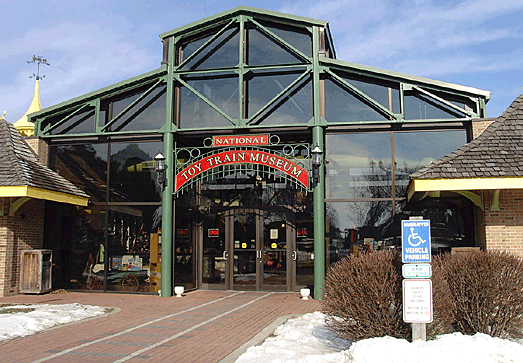
Inside a simulated Victorian California railroad station, it recreates a
large family train room with a variety of layouts and displays of toy
and model trains from the 1850s to the present. The museum owns one of
the most extensive toy train collections in the world. Here, you’ll see
trains that children pushed, pulled or rode upon, as well as miniature
trains, accurate in every detail to their full sized counterparts.
But this is no static display of old trains—far from it. As you enter,
you can hear the whirr of little engines as they chug around the tracks.
And you’ll be able to operate them on five different layouts, displayed
by scale, using a systems of push buttons.
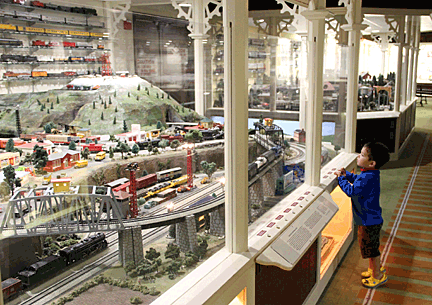 Each
large layout is a different gauge and represents a different period of
the 20th Century. Each offers an interesting variety of period
accessories and extensive scenery. And all are built to enable even the
youngest visitors to have an excellent view of the action. Each
large layout is a different gauge and represents a different period of
the 20th Century. Each offers an interesting variety of period
accessories and extensive scenery. And all are built to enable even the
youngest visitors to have an excellent view of the action.
Train videos, so much a part of model railroading today, run
continuously on a large screen T.V.s
And the museum curators have really gotten creative in their latest
displays of historic and vintage model trains. Two of the most unique
are Harry’s Hardware window display and the Lionel Dealer’s Exhibit.
Generally, the museum displays toy trains by themes or by track gauges
as they might be in actual use on someone’s model train layout.
Individual enthusiasts and members of model railroad clubs create large
layouts which demand dedicated care and maintenance.
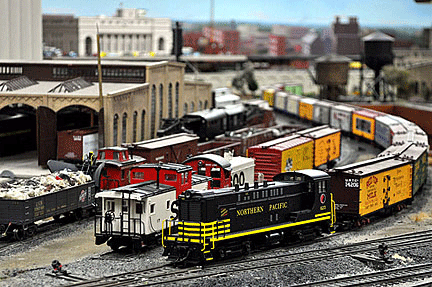 Although
toy trains go back only to the 1860s in Europe, real trains have been
around since the 1830s and the invention of the steam engine. The first
toy trains were made of wood or metal. Although
toy trains go back only to the 1860s in Europe, real trains have been
around since the 1830s and the invention of the steam engine. The first
toy trains were made of wood or metal.
It wasn’t until 1901 that Lionel produced its first electric train for
use in store display windows. These trains weren’t built to scale but
served to promote the new form of energy—electricity. Since those first
display window trains, other manufacturers, including Gilbert’s American
Flyer, LGB, known for their large-scale trains, Marx and Marklin have
produced an array of engines and rolling stock. While the two former
makers focused on scale model trains, the two latter made mostly
tin-plate toy trains. Lionel began making toy trains and tried to get
into the scale model market, but its trains lacked the fine scale detail
of those producing scale-model trains, such as Gilbert’s American Flyer.
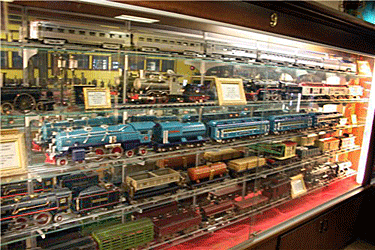 "Tinplate"
is a term collectors use to describe toy trains originally built of thin
stamped metal, but it also includes trains composed of plastic parts as
well. The common thing about these trains is that their manufacturers
built them as toys for mass-market enjoyment rather than the precise
scale of model trains. "Tinplate"
is a term collectors use to describe toy trains originally built of thin
stamped metal, but it also includes trains composed of plastic parts as
well. The common thing about these trains is that their manufacturers
built them as toys for mass-market enjoyment rather than the precise
scale of model trains.
Though the first interest in model trains began in 1934, it wasn’t until
the 1950s that it peaked. Back then, just about every boy wanted a train
set. Trains were a popular gift from Santa Claus and some makers even
produced pink trains to appeal to girls. But those never caught on.
It was during the 1950s that a model railroaders began to make a
distinction between cheaper toy trains for kids and the elaborately
detailed model trains made for adults. Some of these model trains are
exact reproductions of famous trains while others follow more general
themes like freight and passenger trains. And while some boys had
passenger sets, the majority wanted freight trains because of all the
accessories available for them.
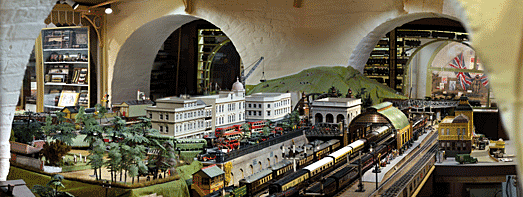
The Museum showcases a variety of accessories. Train catalogs bulged
with photos of coal and barrel loaders, working cattle cars, trackside
signals, bridges, working drop-down traffic gates—the list goes on and
on.
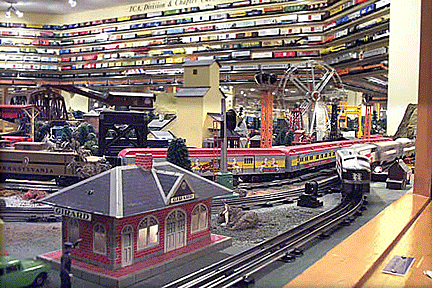 While
the National Toy Train Museum contains just about every toy and model
train that was made, dedicated model railroaders have created detailed
scale worlds where the trains even run on a time schedule. Especially at
this time of year, you can see holiday exhibits featuring model trains
in church and firehalls, basements of train collector club members, and
special store displays. While
the National Toy Train Museum contains just about every toy and model
train that was made, dedicated model railroaders have created detailed
scale worlds where the trains even run on a time schedule. Especially at
this time of year, you can see holiday exhibits featuring model trains
in church and firehalls, basements of train collector club members, and
special store displays.
Today, model trains run the gamut from super tiny “Z” gauge all the way
up to trains large enough to ride on through a garden layout. And lest
they be left behind in this digital age, model train enthusiasts have
embraced technology with onboard and wireless control systems. Wiring on
many layouts is so complicated that professional help is often required.
You’ll see plenty of this technology at the National Toy Train Museum.
This isn’t a place for stodgy old antiques, but instead is the home of
fine craftsmanship and ingenuity.
FOR MORE INFORMATION
The National Toy
Train Museum is open from 10 A.M. to 5 P.M. on weekends. Call
717-687-8976.
<
Back to More Antiques to View
Next
Article > |
